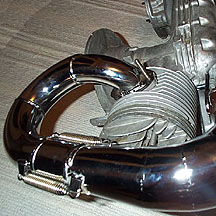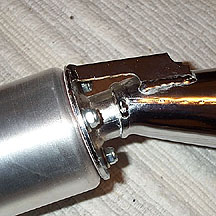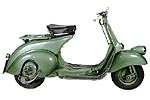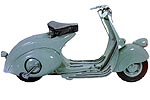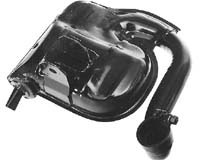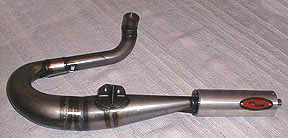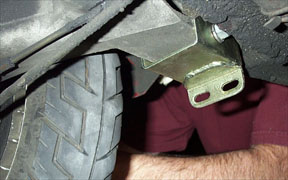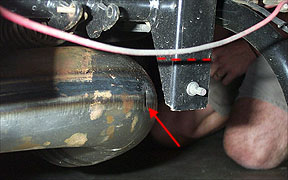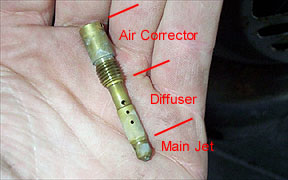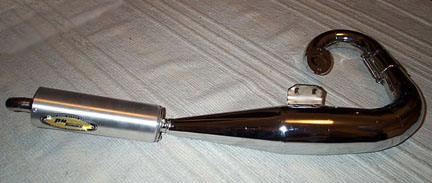Selasa, 15 September 2009
1950's Electrical Diagrams
1950's Electrical Diagrams | ||||||||||
Vespas
| Lambrettas
| |||||||||
1960's Electrical Diagrams
1970's Electrical Diagrams
Vespa Large Frame Gearing
Vespa Large Frame Gearing
The Vespa gearbox has used basically same set up since the first bike rolled off the assembly line. Small frames, wide body bikes, and large frames all use variations of this system.
Below is an overview of a typical large frame Vespa gearbox.
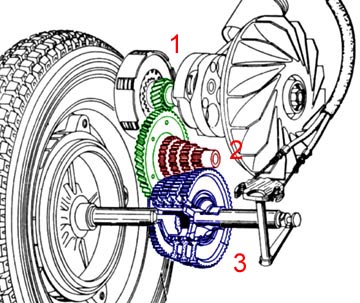
- The Primary Drive - A small gear is attached to the drive plate of the clutch and it mates with a helical cut gear which is riveted to the input shaft. These rivets can be drilled out to change the primary drive but usually the small clutch gear must also be changed.
- The Input Shaft- This has the 3 or 4 gears machined into a single piece sometimes called a 'Christmas Tree'. The kickstart gear turns on the end of this shaft.
- Output Shaft/ Separate Gears- These mesh with the Christmas Tree and a small selector engages a single gear with the output shaft.
The Primary Drive
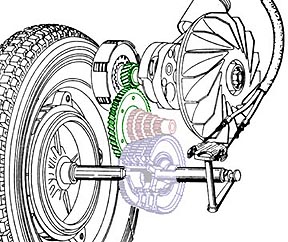
This is where the Vespa gearbox is less flexible then the Lambretta gearbox. In most cases the large helical gear and the smaller clutch gear must be changed as a pair. In comparison, a Lambretta gearbox allows each of these two items to be changed independently because a larger chain can take up the slack. With a Vespa, if one gear diameter increases the other must decrease because since they physically meet, their relationship must always be the same. There are kits on the market from Polini and Malossi that require drilling the rivets out of the gears and allow you to retain the standard Christmas tree gear cluster, while changing the primary drive to a higher, non-standard ratio. A list of some combinations are listed on the Vespa gear calculator page by small gear/large gear teeth (ex 23/65 for a P200E).
The Input Shaft
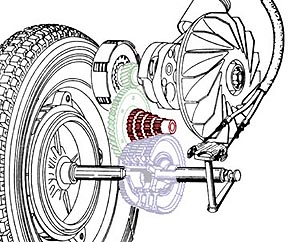
Other than a few exceptions the input shaft gears and the separate gears on the output shaft must be changed as a pair. An exception is the T5 4th gear that can be installed in a P200 standard box to give higher RPM in 4th gear. Most after market expansion chambers create more power at higher RPMs than the standard exhaust, but less power than a standard exhaust at lower RPMs. There is a larger gap between the P200E 3rd and 4th gears than any other gear gap. This means that with an expansion chamber you may not have the power to reach the type of RPMs the pipe needs to perform well in 4th gear. Surprisingly if you make the gap smaller you may actually have a faster top speed.
The Output Shaft
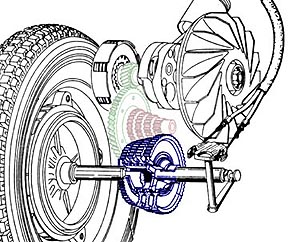
The output shaft gears are independently machined but should always go in as a group. This is the final drive, and a small machined cross locks each gear rotation independently to the output shaft rotation which is rigidly attached to the rear wheel. So all the gears spin when the bike is moving, by rotating freely on the output shaft, but only one gear at a time drives the shaft. The metal cross is moved up and down the output shaft by the gear twist grip on the handlebars.
The next section allows you to mess around with different gearing options. Keep in mind that some of the combinations involve drilling out the rivets of the clutch drive which is a bit of a pain.
Vespa P-Series Gearing Calculator
The scope of Vespa gearing is less broad than Lambrettas but still complicated. There are 2 things that can be changed to result in higher or lower than standard gearing. The primary drive consists of a smaller helical gear that is integral with the clutch assembly and a larger helical gear riveted to a cluster of 4 toothed gears.
These must be installed as a matched pair except in some cases where a free gear with one less tooth can be added to the output shaft and still mate with the cast gear cluster (such as a T5 4th in a P200 gearbox. Lastly the tire size can be adjusted with slight modification to fit a nonstandard 4.00x10 tire. I also included a 3.00x8 tire for anyone who replaces their engine with a P-Series one on an older 8" wheel large frame and wants to keep the original 8" look.
Below are calculators for the three main Vespa gearbox options that will give gearing for a range of standard Vespa gearboxes without mixing separate gears from different models. These are currently only for P-series bikes. If anyone has info on 150 Supers and other 70's bikes please email me.
- The helical primary gear - "Primary Gear"
- The gearbox group (from a standard Vespa model) - "Gearbox Type"
- The tire size used - "Tire Size"
I have included some primary drives kits by Malossi and Polini. P125 & 150 ratios have also been shown in the P series calculator as they can be modified to fit a P200 clutch by unriveting the central clutch gear from a P125 clutch and reattaching it to a P200 style clutch. The final ratio of a conversion like this will be pretty low but try it and see if it works for what you are trying to achieve. The resulting page will show gear ratios for each of the 4 gears and show an RPM to speed analysis at various engine revolutions. Also I have added some Vespa Cosa clutch options that I was sent by email.
P-Series Gearing Calculator
Miles per Hour
Kilometers per Hour
Primary Gear
Gearbox Type
Tire Size
Vespa Small Frame Gearing Calculator
The scope of Vespa gearing is less broad than Lambrettas but still complicated. There are 2 things that can be changed to result in higher or lower than standard gearing. The primary drive consists of a smaller helical gear that is integral with the clutch assembly and a larger helical gear riveted to a cluster of 4 toothed gears.
These must be installed as a matched pair on small frames. Lastly the tire size can changed.
Below are calculators for the two main small frame Vespa gearbox options that will give gearing for a range of standard Vespa gearboxes without mixing separate gears from different models.
- The helical primary gear - "Primary Gear"
- The gearbox group (from a standard Vespa model) - "Gearbox Type"
- The tire size used - "Tire Size"
I have included some primary drives kits by Malossi and Polini. The resulting page will show gear ratios for each of the 3 or 4 gears and show an RPM to speed analysis at various engine revolutions.
Small Frame Gearing Calculator
Miles per Hour
Kilometers per Hour
Primary Gear
Gearbox Type
Tire Size
Exhausts - General
Exhausts - General
The standard exhausts for both a Lambretta and a Vespa are very basic and don't do an awful lot to help the motor produce what it is capable of. The exhaust is also the easiest part to bolt on to your bike and gets the most bang for the buck. Many companies have done research into exhausts for scoots and they range greatly. Some pipes give a great spread of power over the RPMs but others only hit between a specific RPM range. The following section doesn't really rate exhaust systems but does note how to install the most common ones.
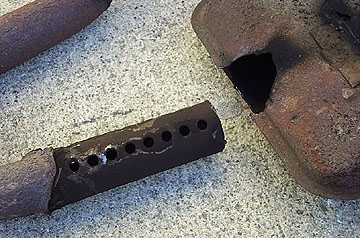
Above is a shot of a standard Vespa P200E exhaust that fell apart...not exactly cutting edge but it does the job until you start messing with your engine. Then it becomes a restriction to the possible performance.
Sito Plus Exhaust - Large Frame
Putting on a Sito exhaust for a large frame bike is just the same as replacing the standard silencer. It gives a little more power, a throatier sound, but unfortunately, less ground clearance.
The first step is to remove your old box style exhaust which is held in place by a single 13mm nut at the barrel stub and another 14mm which passes through the swing arm.
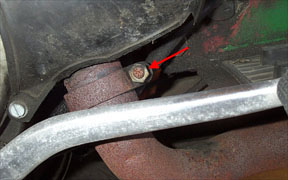
The swing arm bolt is a little annoying as it will almost come out but then hits the rear tire. You can either deflate the tire or remove it to get this free - we removed it for the pictures.
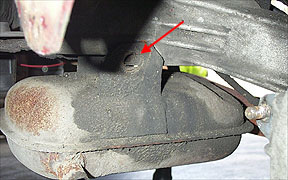
With a little twisting and turning the exhaust should drop off the barrel stub. If it is stubborn try heating the stub, tapping the edge with a hammer and screw driver, or soaking it in a solvent.
Once the old exhaust is off the Sito can simply go in its place. The Sito definitely gives a little more power than standard. We raced 2 P200s that were always neck and neck with standard silencers and then changed one of them to a Sito. The difference was that the bike could rev higher before having to change gears which allowed it to pull forward by about a bike length before the 1st to 2nd change. After that it just kept on pulling further away at each gear change. I would estimate it may give you about 5 MPH more top speed overall, and not much more power at the same revs, but the ability to hold onto each gear for longer because of the high revving capabilities.
The downside is that it has less ground clearance. When you ride with a passenger it is easy to bottom out on left hand turns which is a little scary. Below is a quick shot with no load on the bike. You can see that even with no load the exhaust grounds out well before the stand.
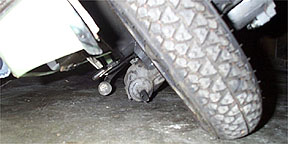
PM Tuning Exhaust - Large Frame Vespa
Putting on a PM Tuning exhaust for a large frame bike is a pretty easy job but there are a few things to know. Firstly here is what is included with the pipe:
- 3x part pipe (stub from barrel, main body, and exhaust can)
- 3x nylon locking nuts for the exhaust can
- 2x springs to connect the pipe parts together and allow it to pivot for changing the rear wheel.
- 1x U-bend clamp. I've heard these can be dangerous on Malossi kits which have a cast exhaust stub, but they are fine on standard barrels.
- 1x mounting bracket and all associated hardware
The pipe comes from PM Tuning either as unfinished steel or chrome. The one I got was unfinished and it started rusting just from handling. In the pictures below there is some surface rust but I eventually bought some 500F heat resistant clear spray, sanded down the pipe, and sprayed everything but the exhaust can which is was aluminum.
The first step is to remove your old box style exhaust which is held in place by a single 13mm nut at the barrel stub and another 14mm which passes through the swing arm. The swing arm bolt is a little annoying as it will almost come out but then hits the rear tire. You can either deflate the tire or remove it to get this free - we removed it for the pictures.


With a little twisting and turning the exhaust should drop off the barrel stub. If it is stubborn try heating the stub, tapping the edge with a hammer and screw driver, or soaking it in a solvent.
Once the old exhaust is off the new PM mounting bracket can be installed. You'll need a nut for the existing swing arm exhaust bolt as the original Vespa exhaust has one built in. On my brother's bike (pictured) the mount fit well but on my P200 engined VBA I had some problems. The flange should be facing out towards the spare wheel side as shown below.
At this point we put the rear wheel back on. This pipe does allow for a spare tire with some spacers on the spare tire mounting. It also hinges at the spring point so that the tire can be removed to change it without removing the entire system
At this point you may want to modify your kick stand or it is possible to do it later. Place the U-bend clamp on the barrel end of the pipe, but leave it loose. With the bike on the kickstand fit the pipe to the barrel, and slide it on as far as it will go. Loosely tighten the nuts just enough so it won't slide off. Use the included 2 small bolts and nuts to connect the main pipe body to the mounting bracket. There is also a small foam spacer that goes between the bracket and the main pipe to help reduce vibration. Once everything is fitting well, tighten up all the nuts.
As you can see from the picture below the kick stand on a P series bike does not work with the new pipe. We didn't know this at the time, tried to take the bike off the stand, and ended up with a nice dent in the new pipe (shown with the arrow)!! The solution is to cut about 1" (2.5cm) or so off the bottom of the left hand side stand buffer as shown with the dotted line.
The last step is to replace the main jet for a larger one and to change the spark plug to a different grade. PM Tuning recommends a 118 main jet to replace a standard 116 jet on a P200 and an NGK B85EGV spark plug. Replacing the plug is a simple matter of unscrewing the old plug and dropping the new one in. The main jet is located within the carb body at the end of a three part brass jet assembly. Remove the right hand cowling to get access to the carb box and remove the screws arrowed in the picture below.
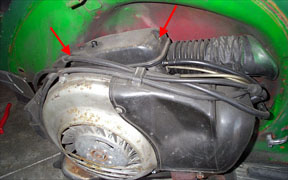
Once the carb box top is off the air filter will be exposed. There are two screws which hold the filter to the carb body which need to be removed. They are arrowed in the picture below.
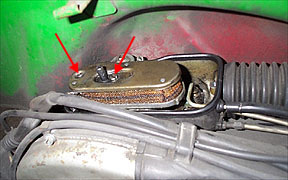
With the filter off the tops of the jets are visible. Remove the largest one (arrowed below) by unscrewing in a counter clockwise motion.
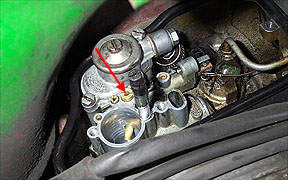
The jet is made up of three parts and the main jet is the small tip of the assembly. To remove it just poke a wire or something through the hole and pull it from the diffuser tube. This is just a friction fit and should pull out pretty easily. Fit the new jet and refit the jet assembly in the carb body. The orientation of the jet does not matter so the hole can point any direction. See below for a detailed view of the main jet assembly.
Once all these items are reinstalled the scoot should be ready for a test run. Be careful to monitor the plug color once the pipe has been installed. A lean mixture can be created with a pipe which can destroy the engine. The plug should be a chocolate brown when the engine is set correctly.
SIP P200 Exhaust for Vespa 200cc
I had the pleasure of fitting a SIP P200 pipe for a friend (thanks TJ) and there is no doubt this is a really nice exhaust!! This pipe will fit a Rally 200 and any 200cc P-Series bike, but means that you will no longer be able to carry a spare under the left body cowl. It think it is ideally suited to engine transplant bikes such as a 200cc engine in a 60's style bike where the left side body cowl is a glovebox anyway.
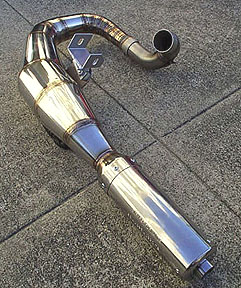
What you will need for installation:
- 14mm wrench or socket
- 13mm wrench or socket
- Pliers or vice grips
- Large main jet (we used a 116 but haven't messed around with larger jets yet)
The quality of the pipe is beautiful. All the welds are extremely tight and beautifully finished off, the metal is a nice thick gauge for long life and the entire pipe is made of stainless steel so it will not rust over time. The pipe comes in two pieces: the exhaust leader and the main body. We got ours at First Kick in SF for about the same price it would be after shipping from SIP in Germany...but no waiting because they have them in stock.
Included with the pipe is a powdercoated or enameled steel bracket with nuts welded to it which attaches to the engine swing arm. The bracket on the exhaust has nylon type spaces for controlling vibration, and comes with two bolts and lock washers. Also included are three springs and a small plate with two holes in it for mounting as the pipe doesn't clamp around the exhaust stub like a typical exhaust.


The first step is to remove your old box style exhaust which is held in place by a single 13mm nut at the barrel stub and another 14mm which passes through the swing arm. The swing arm bolt is a little annoying as it will almost come out but then hits the rear tire. You can either deflate the tire or remove it to get this free - we removed it for the pictures.
With a little twisting and turning the exhaust should drop off the barrel stub. If it is stubborn try heating the stub, tapping the edge with a hammer and screw driver, or soaking the join in a solvent. Once this is done you will need a new 14mm nut and washer because the standard Vespa exhaust uses a built in 14mm nut for the swingarm bolt. We just decided to hack up the old exhaust to get the nut out, because the exhaust was way beyond repair.
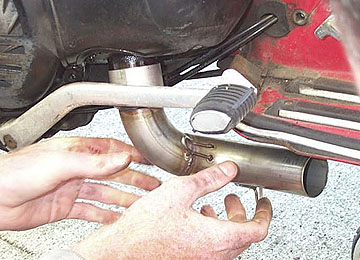
We removed the exhaust leader from the exhaust body and fitted it to the barrel stub. SIP have incorporated only springs to secure the leader to the barrel which works well for standard barrels, and is really nice for Malossi 210 type barrels. Standard barrels have a steel exhaust stub, but Malossi barrels have cast aluminum barrel stubs that can fracture if you use a U-clamp or other constricting devices. The leader is a perfect fit over the standard exhaust stub so we used a little WD40 to slide it all the way on.
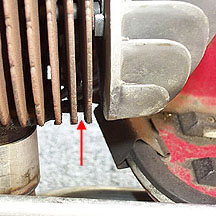
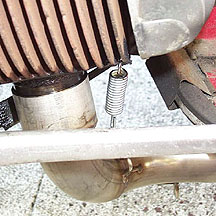
A newer type standard barrel has two pegs which connect the top two cooling fins to the lower fins as shown with the arrow in the above left picture. We chose to use the upper one because it looked like a better angle to the leader hook. One of the springs hooks through this peg and will connect to the exhaust leader once stretched, but we will deal with that after the pipe is fitted. We took the cowling shroud off the engine because we were not sure where to connect the spring, but it is not a required step. If you have an older P200 barrel there will be no pegs here and it is necessary to remove the head and drill one into the first fin (see below).
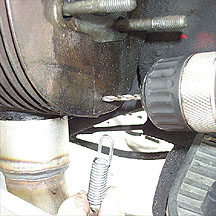

We recently installed a SIP pipe on a second P200E and found there were no pegs to hook the forward spring to, as there were on the previous P200 we used. The previous P200 had a newer engine which was installed by a scooter shop, so I guess the pegs were added on later models. We decided to remove the head and use a 1/8" drill bit to put a hole in the uppermost fin. Remove the cylinder shroud and then the head by unbolting the 4 13mm nuts, and drill a hole about 3/8" up and just to the frame side of the barrel casting lip.
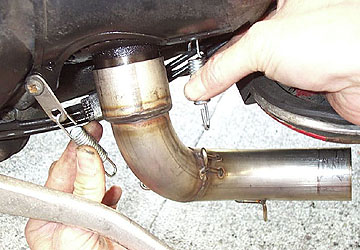
The other leader spring is held to the flywheel casing screw by a small metal plate that is included with the exhaust. These two springs connect to the hooks on the leader and are both the same length. Now on to the main body fitting.
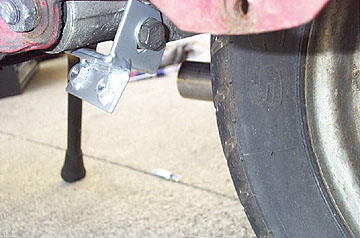
The SIP clamp can be removed from the exhaust body and the bolts should be set aside for safe keeping. It needs to be installed at a funny angle as shown in the photo above. Once installed just tighten the main 14mm bolt enough to hold it in position, but loose enough to allow adjustment of the clamp. We put our rear wheel back on after the clamp was installed. The leader can be seen in the foreground in front of the rear wheel.
Before you put the main body of the exhaust on check where the stand spring connects to the floor rib just in front of the swingarm. We found that on our P200E there are a few rectangular holes in the rib for the stand spring and ours was not in the one closest to the center. The exhaust fits much better when the stand spring is in the most central hole available.
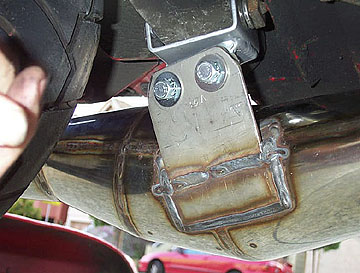
Although we didn't use it, it would make sense to add a heat resistant sealer at the joints of the pipe. The joints are extremely tight but a sealer would ensure that it is air tight. Now slide the exhaust body onto the leader and rotate it up to meet the exhaust mount. Since the springs have not been attached on the leader it should all move quite easily until the mount and exhaust align. Thread the two securing bolts by hand and then check that everything is aligned properly. Once you are happy tighten down all the bolts and you can attach all the barrel and leader springs.
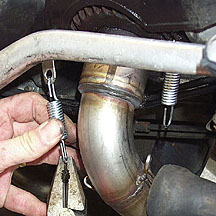
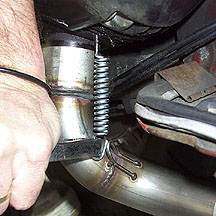
After many years of skinned knuckles I think this is the only way to do this. Use a pair of pliers and have a friend steady the bike. Grab the end very firmly and stretch the spring until it can be hooked into the leader. Use the same technique to connect the leader to body spring.
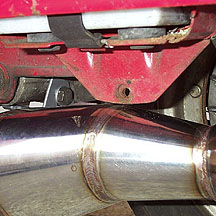
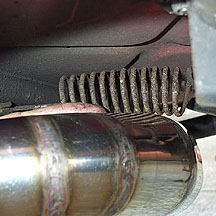
The only downside I can see about this pipe is the clearance to parts of the frame. We found the mount that receives the spare wheel plastic blank lower hits the pipe when the rear shock is compressed as shown in the upper left image. I guess this really isn't a problem because you can't mount a spare wheel here anyway with this exhaust. We also found that the stand spring rubs against the top of the pipe when the stand is extended and there is no weight on the bike. When the stand is up the spring is clear.
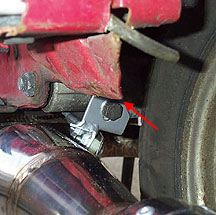
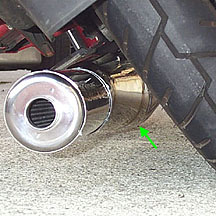
Our solution to the metal flange problem was to bend it out of the way as shown in the above left image (red arrow). If someone has this bike in the future and wants a standard exhaust and tire then they can easily bend it back. Ground clearance is good - the center of the exhaust is the first to make contact at about 50 degrees (shown with the green arrow). The final step is to change the main jet to about a 116 if it is not currently in your bike. Click here for a quick guide on how to change it.
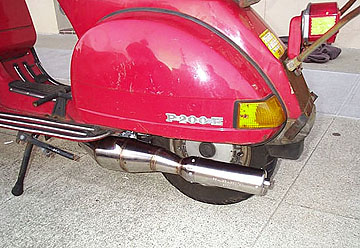
The difference it makes to the bike is really nice. It is louder than standard but still quiet enough for daily road use. First impressions where that it definitely allows the engine to rev much higher than standard in every gear and you can feel the powerband kick in at around 4500 RPM in any gear. It looks great on the bike and I would guess that it could also be polished before installation for a finish that is close to chrome but will not rust. We'll have some more info after TJ rides it for a while.
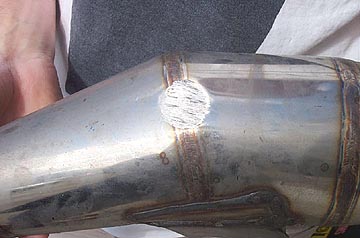
A final note: it is possible to ground out almost every exhaust on a Vespa (even the original). My brother grounded this SIP pipe out on a flat road with his wife on the back while leaning a little too hard into a corner. The biggest problem about an expansion chamber is the lack of ground clearance...so be aware.
PM Tuning Exhaust - Lambretta
PM Tuning make a bunch of different pipes for both Vespas and Lambrettas. This one is for a TS1 barrel kit and comes either as unfinished steel or polished chrome. The one I got was chrome, but they still recommend a clear sealer over the chrome. I can't imagine that this looks as good as the chrome alone but the results will definitely wear better. I haven't decided yet if I will coat it with high temp clear.
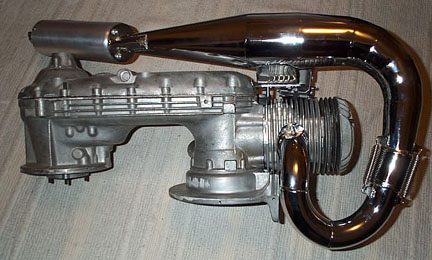
The pipe fits beautifully under the engine with only a single mount to the same location as a standard exhaust. There is a rubber gasket between the engine mount and the exhaust to lessen the vibration transmission between the two. The end can is removable if it needs to be replaced or re-packed as required. The shot below and above are just rough fits of the pipe on the TS1 engine I am building so I don't know how it will fit with all the engine cooling shrouds in place.
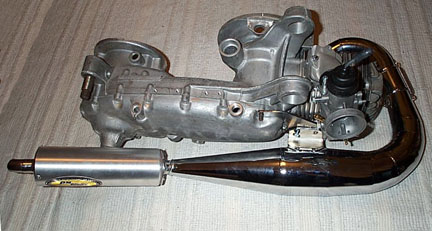
Below are a couple of detail shots of the reinforcing at the exhaust can, and the connection at the exhaust port. There is a slip joint with springs which allow the pipe to fit perfectly against the engine mounts. PM Tuning includes basic instructions on how to install the pipe. I will add to this page when I install my engine in the bike.
